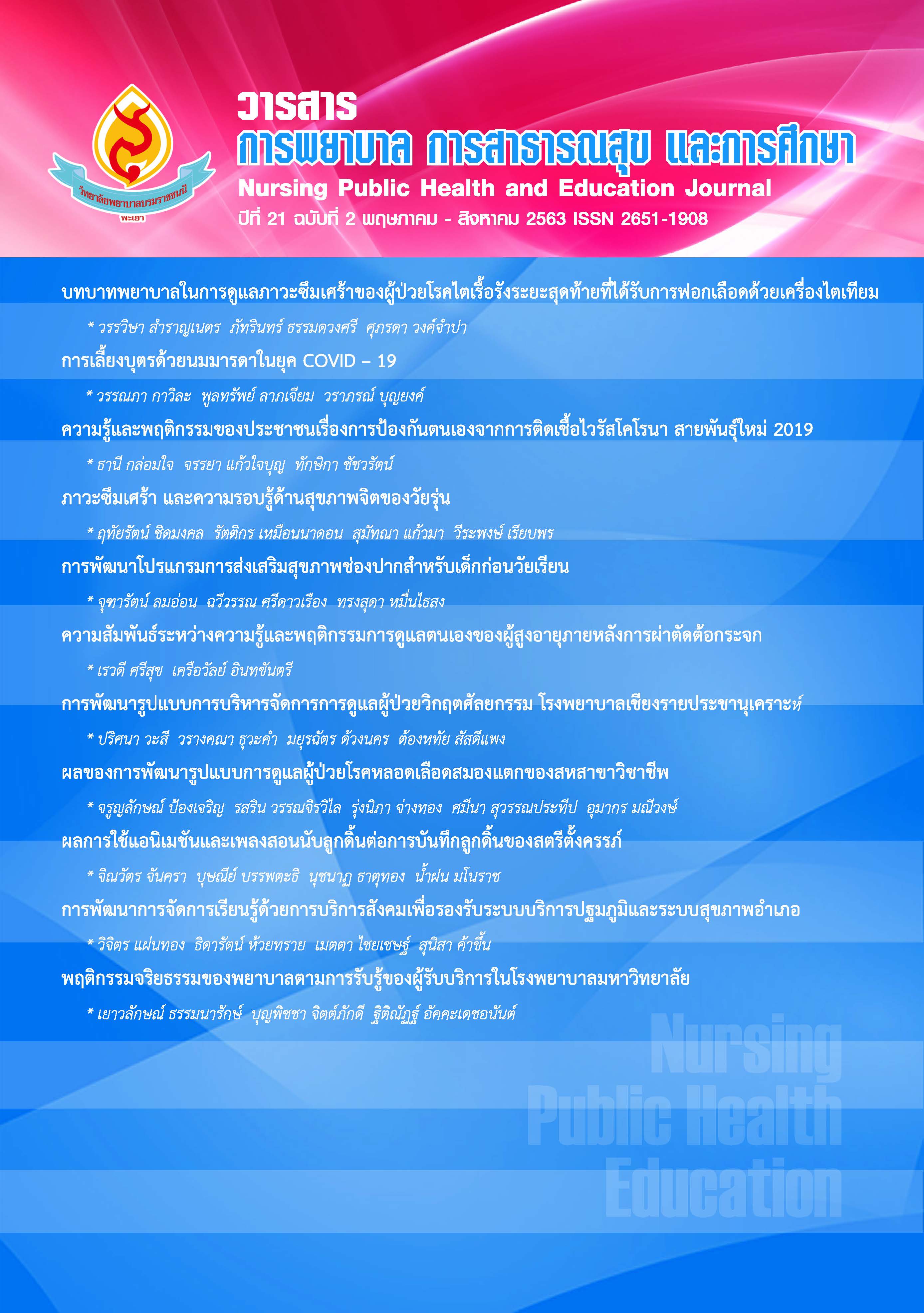การพัฒนารูปแบบการบริหารจัดการการดูแลผู้ป่วย วิกฤตศัลยกรรม โรงพยาบาลเชียงรายประชานุเคราะห์
คำสำคัญ:
รูปแบบการบริหารจัดการ, ผู้ป่วยวิกฤตศัลยกรรมบทคัดย่อ
การวิจัยพัฒนา (Development Research) นี้มีวัตถุประสงค์เพื่อพัฒนารูปแบบการบริหารจัดการการดูแลผู้ป่วยวิกฤตศัลยกรรม และศึกษาประสิทธิผลของรูปแบบการบริหารจัดการการดูแลผู้ป่วยวิกฤตศัลยกรรม โรงพยาบาลเชียงรายประชานุเคราะห์ ในผู้ป่วยวิกฤตศัลยกรรมที่เข้ารับการรักษาในโรงพยาบาลเชียงรายประชา นุเคราะห์ ตั้งแต่วันที่ 1 ก.ค. 2561 ถึง 30 ก.ย. 2562 เปรียบเทียบผลลัพธ์สองกลุ่มด้วยสถิติ Fisher’s exact test สถิติ independent t-test และ paired t-test ผลการวิจัยได้รูปแบบการบริหารจัดการการดูแลผู้ป่วยวิกฤตศัลยกรรมประกอบด้วย 1) การพัฒนาสมรรถนะของพยาบาลรายบุคคล 2) การใช้เทคนิคการสื่อสารที่มีประสิทธิภาพในการนิเทศทางการพยาบาล (SBAR) 3) การประเมินการรับย้ายผู้ป่วยเข้าและออกในหอผู้ป่วยวิกฤตศัลยกรรมโดยใช้ triage score และ 4) แนวปฏิบัติการดูแลผู้ป่วยวิกฤตศัลยกรรมโดยใช้ MEWS และ SOFA scores ส่วนการประเมินประสิทธิผลของรูปแบบการบริหารจัดการการดูแลผู้ป่วยวิกฤตศัลยกรรม พบว่า ผู้ป่วยกลุ่มก่อนและหลังใช้รูปแบบการดูแลผู้ป่วยวิกฤตศัลยกรรมมีอัตราการเสียชีวิตของผู้ป่วยระหว่างรอย้ายเข้าหอผู้ป่วยหนัก อัตราการใส่ท่อช่วยหายใจซ้ำภายใน 24 ชั่วโมงหลังย้ายผู้ป่วยออกจากหอผู้ป่วยหนัก อัตราการกลับเข้ามารักษาซ้ำในหอผู้ป่วยหนักภายใน 72 ชั่วโมงไม่แตกต่างกัน ยกเว้นจำนวนวันนอนเฉลี่ยที่ผู้ป่วยรอย้ายเข้าหอผู้ป่วยหนัก (mean=2.35, SD=1.16, mean=1.04, SD=0.43, p=0.001) ร้อยละของพยาบาลที่มีสมรรถนะผ่านเกณฑ์ในด้านการพยาบาลผู้ป่วยวิกฤตศัลยกรรม (ร้อยละ 85.7, ร้อยละ 97.7, p<0.001) การพยาบาลผู้ป่วยที่ได้รับบาดเจ็บ (ร้อยละ 82.8, ร้อยละ 94.9, p<0.001) และการพยาบาลผู้ป่วยศัลยศาสตร์หัวใจและทรวงอก (ร้อยละ 72.0, ร้อยละ 89.1, p<0.001) ตลอดจนคะแนนความพึงพอใจของพยาบาลต่อรูปแบบการบริหารจัดการการดูแลผู้ป่วยวิกฤตศัลยกรรม (mean=80.40, SD=3.77, mean=90.36, SD=2.71, p=<0.001) ของทั้งสองกลุ่มแตกต่างกันอย่างมีนัยสำคัญทางสถิติ
เอกสารอ้างอิง
กลุ่มงานการพยาบาลผู้ป่วยหนัก. (2561). รายงานประจำปีกลุ่มงานการพยาบาลผู้ป่วยหนัก. เชียงราย: โรงพยาบาลเชียงรายประชานุเคราะห์.
กวีศักดิ์ จิตตวัฒนรัตน์. (2560). ระบบการให้ระดับความรุนแรงของโรคในไอซียูศัลยกรรม (Disease Severity Score System). ใน กวีศักดิ์ จิตตวัฒนรัตน์ (บรรณาธิการ), เวชบำบัดวิกฤตศัลยศาสตร์ในเวชปฏิบัติ: Surgical Critical Care in Practice (หน้า 15-40). กรุงเทพฯ: คณะแพทยศาสตร์ มหาวิทยาลัยเชียงใหม่.
ธเนศ ฉัตรมงคลวัฒน์. (ม.ป.ป.). ICU admission, discharge and triage guideline volume 1: ICU เขาหรือเราที่ไม่เข้าใจ. ใน ศุภโชค มาศปกรณ์ (บรรณาธิการ), ศัลยศาสตร์จะยากไปไหน. กรุงเทพฯ: โครงการตำราศัลยศาสตร์ โรงพยาบาลเชียงรายประชานุเคราะห์.
มยุรฉัตร ด้วงนคร. (2558). การพัฒนากรอบสมรรถนะของพยาบาลวิชาชีพ หอผู้ป่วยวิกฤตศัลยกรรม โรงพยาบาลเชียงรายประชานุเคราะห์ (การค้นคว้าแบบอิสระ พยาบาลศาสตร์มหาบัณฑิต สาขาวิชาการบริหารการพยาบาล) บัณฑิตวิทยาลัย มหาวิทยาลัยเชียงใหม่.
ตุลา วงศ์ปาลี, พุทธชาติ สมณา และจิตราวดี จิตจันทร์. (2556). ผลของการใช้ MEWS ในการดูแลต่อเนื่องของหอผู้ป่วยกึ่งวิกฤต และหอผู้ป่วยหนัก งานการพยาบาลผู้ป่วยอายุรศาสตร์. สืบค้นเมื่อวันที่ 8 มีนาคม 2563, จาก https://w2.med.cmu.ac.th/nis/downloads/?p=549
ศูนย์ข้อมูล. (2561). รายงานประจำปี 2561. เชียงราย: โรงพยาบาลเชียงรายประชานุเคราะห์.
สถาบันพัฒนาข้าราชการพลเรือน สำนักงาน ก.พ. (2560). โครงการฝึกอบรมเสริมหลักสูตรนักบริหารระดับสูง (ส.นบส.). สืบค้นเมื่อวันที่ 8 มีนาคม 2563, จาก ttps://www.ocsc.go.th/sites/default/files/attachment/article/01_khuumuue_s.nbs_idp_final.pdf
สมพิศ จันทราเรืองฤทธิ์. (2550). การพัฒนารูปแบบการนิเทศของผู้ตรวจการพยาบาลนอกเวลาราชการ โรงพยาบาลนางรอง จังหวัดบุรีรัมย์. สำนักวิชาการบริหารการพยาบาล บัณฑิตวิทยาลัย มหาวิทยาลัยขอนแก่น
อาภรณ์ ภู่วิทยพันธุ์. (2553). competency-based training road map. กรุงเทพฯ: เอช อาร์ เซ็นเตอร์.
Benner, P. (1984). From Novice to Expert: Excellence and power in clinical nursing practice. Menlo Park: Addison-Wesley.
Ferreira, F., Bota, D., Bross, D., Melot, C., & Vincent, J. L. (2011). Serial evaluation of the SOFA score to predict outcome in critically ill patients. JAMA, 286,1754-58.
Gooch, R., & Kahn, J. (2014). Icu bed supply. JAMA, 311(6),567-68.
Hitchcock, M., Gillespie, B., Crilly, J., & Chaboyer, W. (2014). Triage: an investigation of the process and potential vulnerabilities. J Adv Nurs, 70(7),1532-41.
Institute for Healthcare Improvement. SBAR: Situation-background-assessment recommendation. [Internet]. Boston: 2017 [cited 2018 Oct 10]. from: https://www.lsqin.org/wp-content/ uploads/2017/08/SBARTechniquefor Communication.pdf
Paterson, R., MacLeod, D. C., Thetford, D., Beattie, A., Graham, C., Lam, S., & Bell, D. (2006). Prediction of in-hospital mortality and length of stay using an early warning scoring system: clinical audit. Clinical Medicine, 6(3), 281–84.
Polit, D., & Hungler, B. (1999). Nursing Research: Principle and Method, 6th ed. Philadelphia: Lippincott Company.
Proctor, B. (2001). Training for the supervision alliance Attitude, Skills and Intention. In Cutcliffe J. R., Butterworth T, & Proctor B, Fundamental Themes in Clinical Supervision (p.25-46). London: Routledge.
Rowan, K. M., Kerr, J.H., Major, E., McPherson, K., Short, A., & Vessey, M. P. (1993). Intensive care society's APACHE II study in britain and ireland-II: Outcome comparisons of intensive care unit after adjustment for case mix by the american APACHE II method. BMJ, 307,977-81.
Saenprasan, P. (2016). Nursing Supervision; competency & Individual Development Plan. Bangkok: Paper presented at the meeting of Royal Thai army nurses association.
Society of Critical Care Medicine. (1999). Guidelines for intensive care unit admission, discharge, and triage: Task force of the american college of critical care medicine. Crit Care Med, 633-38.
Young, M. P., McBride, K., James, B., Fisher, ES., & Gooder, V. J. (2003). Inpatient transfers to the itensive care unit: delays are associated with increased mortality and morbidity. J Gen Intern Med, 8,77-83.
ดาวน์โหลด
เผยแพร่แล้ว
รูปแบบการอ้างอิง
ฉบับ
ประเภทบทความ
สัญญาอนุญาต
ลิขสิทธิ์ (c) 2020 วารสารการพยายาล การสาธารณสุข และการศึกษา

อนุญาตภายใต้เงื่อนไข Creative Commons Attribution-NonCommercial-NoDerivatives 4.0 International License.



